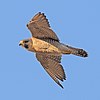Birds by flying speed
| Common name | Image | Species | Family | Average horizontal speed | Maximum horizontal speed | Maximum airspeed | Remark |
|---|---|---|---|---|---|---|---|
| Peregrine falcon |  | Falco peregrinus | Falconidae | 65–90 km/h 40–56 mph [4] | 110 km/h 68 mph [4] | 389 km/h 242 mph [5] | High-speed dive—pointed long wings |
| Saker falcon |  | Falco cherrug | Falconidae | 150 km/h 93 mph [6] | 320 km/h 200 mph [7] | High-speed dive—pointed long wings | |
| Golden eagle |  | Aquila chrysaetos | Accipitridae | 45–51 km/h 28–32 mph [8] | 129 km/h 80 mph [8] | 322 km/h 200 mph [8] | |
| Grey-headed albatross |  | Thalassarche Chrysostoma | Diomedeidae | 127 km/h 79 mph [9] [10] [note 1] | 2.2 m (7 ft 3 in) wingspan allows for high power use from wind. | ||
| Gyrfalcon |  | Falco rusticolus | Falconidae | 80–100 km/h 50–62 mph | 145 km/h 90 mph [11] | 187–209 km/h 116–130 mph [12] | High-speed dive—pointed long wings |
| White-throated needletail |  | Hirundapus caudacutus | Apodidae | 169 km/h 105 mph [3] | 169 km/h 105 mph | High-speed wings | |
| Common swift |  | Apus apus | Apodidae [13] | 111.6 km/h 69.3 mph [3] | 166 km/h 103 mph | High-speed wings | |
| Eurasian hobby |  | Falco subbuteo | Falconidae [14] | 159 km/h 99 mph | Can sometimes outfly the swift as it eats them and catches them on the wing. | ||
| Frigatebird |  | Fregata | Fregatidae [15] | 153 km/h 95 mph | Slow gliding/soaring high aspect ratio | ||
| Spur-winged goose |  | Plectropterus gambensis | Anatidae [16] | 143 km/h 89 mph | High-speed wings | ||
| Red-breasted merganser |  | Mergus serrator | Anatidae [17] | 130 km/h 81 mph | High–aspect ratio wings | ||
| Canvasback |  | Aythya valisineria | Anatidae [18] | 128 km/h 80 mph | High-speed wings | ||
| Common eider |  | Somateria mollissima | Anatidae [19] | 123 km/h 76 mph | High-speed wings | ||
| Eurasian teal |  | Anas crecca | Anatidae | 97 km/h 60 mph | High–aspect ratio wings | ||
| Anna's hummingbird |  | Calypte anna | Trochilidae | 56 km/h 35 mph [20] | 70 km/h 43 mph | Rapidly-beating wings |